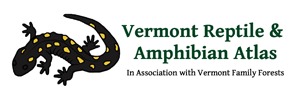Successful Herp Survey in the Northeast Kingdom
Herpers,
this past Friday Matt Gorton, Kate Kelly, and I made a hike into Warners Grant near the Canadian border to locate and photograph reptiles and amphibians. Warners Grant has long been the least surveyed area of Vermont as far as herps are concerned. That is in large part due to the fact that Warners Grant has no human occupants and no roads (it does have one snowmobile trail).
I had long ago picked out the portion of Warners Grant that appeared to be the best habitat for locating the species that needed to be documented. I named it Herpland. Reaching Herpland required a mile hike up a stream valley to an old beaver meadow. We hoped to find Spring Salamanders on the way up (or down), since they had never been found in the grant, but they proved to be at least elusive and perhaps entirely missing. We did find both Northern Two-lineds and Northern Duskies though, as we worked our way up and down the streams.
When we reached the beaver meadow, we proceeded to search the grassy margins of the water for Pickerel Frogs, and to net the waters edge for Eastern Newts and Mink Frogs. Unlike in most of Vermont, Eastern Newts can be very difficult to find in the Northeast Kingdom (NEK). They appear to be missing entirely from large areas and in very low numbers even where they are found. Kate Kelly successfully netted us our first newt and later I was able to find a single Red Eft under a log. These were the first documented individuals of this species from Warners Grant.
Matt Gorton netted a couple Spotted Salamander larvae for us. This was our second new species for the grant.
The other new species for the site was one that I had thought unlikely: the American Bullfrog. Yet, in our search for Mink Frogs (unsuccessful), we caught and photographed the grant’s first American Bullfrog. It was just a young recently-metamorphosed bullfrog, so they may or may not breed there, since the young will travel long distances.
In all, we located ten herptile species including three that had never been documented from that “town”. In my view, this was a big success. This dropped Warners Grant from a total of eleven undocumented-but-suspected species to just eight.
So, what is now the political entity (towns, cities, gores, and grants) that has the lowest number of photo-documented herp species? It is Barre City. Since it is a city that is largely developed and highly fragmented, this is not terribly surprising. Still, two of the expected species (Ring-necked Snake and Painted Turtle) have been reported, they just need to be photographed. Nobody has even reported American Bullfrogs, Gray Treefrogs, Snapping Turtles, Eastern Milksnakes, or Spotted Salamanders.
The next highest priority for additional survey is Avery’s Gore. It is also a spot with lots of habitat like Warners Grant, but no permanent residents. It does have a few seasonal roads though. Continuing down the list of priority survey towns are East Haven, St. Albans City (limited habitat), Vershire, and Westfield. If you or anyone you know lives in or near these towns, we could use your help documenting their resident herptiles.
Happy herping!
Jim
We met our fundraising goal for 2020. Thanks!

